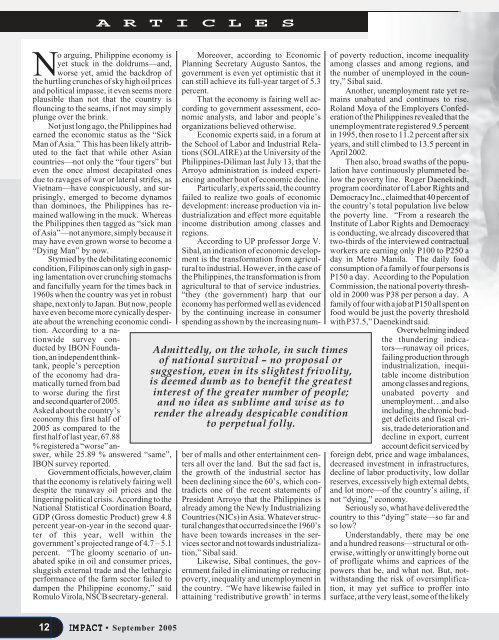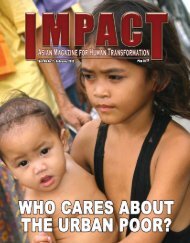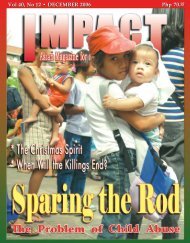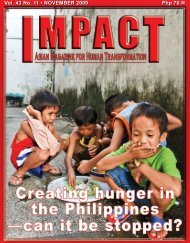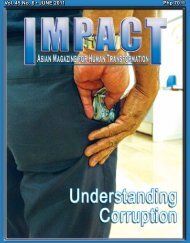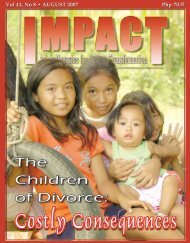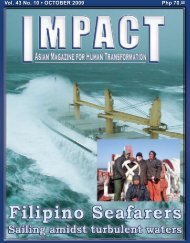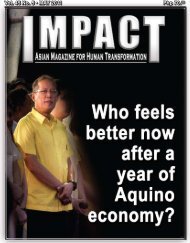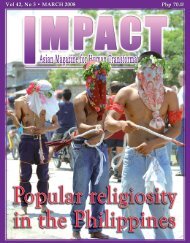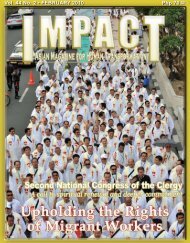SEPTEMBER 2005 Vol 39, No 6 • Php 70.00 Php 70.00 - IMPACT ...
SEPTEMBER 2005 Vol 39, No 6 • Php 70.00 Php 70.00 - IMPACT ...
SEPTEMBER 2005 Vol 39, No 6 • Php 70.00 Php 70.00 - IMPACT ...
- No tags were found...
Create successful ePaper yourself
Turn your PDF publications into a flip-book with our unique Google optimized e-Paper software.
A R T I C L E S<br />
<strong>No</strong> arguing, Philippine economy is<br />
yet stuck in the doldrums—and,<br />
worse yet, amid the backdrop of<br />
the hurtling crunches of sky high oil prices<br />
and political impasse, it even seems more<br />
plausible than not that the country is<br />
flouncing to the seams, if not may simply<br />
plunge over the brink.<br />
<strong>No</strong>t just long ago, the Philippines had<br />
earned the economic status as the “Sick<br />
Man of Asia.” This has been likely attributed<br />
to the fact that while other Asian<br />
countries—not only the “four tigers” but<br />
even the once almost decapitated ones<br />
due to ravages of war or lateral strifes, as<br />
Vietnam—have conspicuously, and surprisingly,<br />
emerged to become dynamos<br />
than dominoes, the Philippines has remained<br />
wallowing in the muck. Whereas<br />
the Philippines then tagged as “sick man<br />
of Asia”—not anymore, simply because it<br />
may have even grown worse to become a<br />
“Dying Man” by now.<br />
Stymied by the debilitating economic<br />
condition, Filipinos can only sigh in gasping<br />
lamentation over crunching stomachs<br />
and fancifully yearn for the times back in<br />
1960s when the country was yet in robust<br />
shape, next only to Japan. But now, people<br />
have even become more cynically desperate<br />
about the wrenching economic condition.<br />
According to a nationwide<br />
survey conducted<br />
by IBON Foundation,<br />
an independent thinktank,<br />
people’s perception<br />
of the economy had dramatically<br />
turned from bad<br />
to worse during the first<br />
and second quarter of <strong>2005</strong>.<br />
Asked about the country’s<br />
economy this first half of<br />
<strong>2005</strong> as compared to the<br />
first half of last year, 67.88<br />
% registered a “worse” answer,<br />
while 25.89 % answered “same”,<br />
IBON survey reported.<br />
Government officials, however, claim<br />
that the economy is relatively fairing well<br />
despite the runaway oil prices and the<br />
lingering political crisis. According to the<br />
National Statistical Coordination Board,<br />
GDP (Gross domestic Product) grew 4.8<br />
percent year-on-year in the second quarter<br />
of this year, well within the<br />
government’s projected range of 4.7 – 5.1<br />
percent. “The gloomy scenario of unabated<br />
spike in oil and consumer prices,<br />
sluggish external trade and the lethargic<br />
performance of the farm sector failed to<br />
dampen the Philippine economy,” said<br />
Romulo Virola, NSCB secretary-general.<br />
Admittedly, on the whole, in such times<br />
of national survival – no proposal or<br />
suggestion, even in its slightest frivolity,<br />
is deemed dumb as to benefit the greatest<br />
interest of the greater number of people;<br />
and no idea as sublime and wise as to<br />
render the already despicable condition<br />
to perpetual folly.<br />
Moreover, according to Economic<br />
Planning Secretary Augusto Santos, the<br />
government is even yet optimistic that it<br />
can still achieve its full-year target of 5.3<br />
percent.<br />
That the economy is fairing well according<br />
to government assessment, economic<br />
analysts, and labor and people’s<br />
organizations believed otherwise.<br />
Economic experts said, in a forum at<br />
the School of Labor and Industrial Relations<br />
(SOLAIRE) at the University of the<br />
Philippines-Diliman last July 13, that the<br />
Arroyo administration is indeed experiencing<br />
another bout of economic decline.<br />
Particularly, experts said, the country<br />
failed to realize two goals of economic<br />
development: increase production via industrialization<br />
and effect more equitable<br />
income distribution among classes and<br />
regions.<br />
According to UP professor Jorge V.<br />
Sibal, an indication of economic development<br />
is the transformation from agricultural<br />
to industrial. However, in the case of<br />
the Philippines, the transformation is from<br />
agricultural to that of service industries.<br />
“they (the government) harp that our<br />
economy has performed well as evidenced<br />
by the continuing increase in consumer<br />
spending as shown by the increasing number<br />
of malls and other entertainment centers<br />
all over the land. But the sad fact is,<br />
the growth of the industrial sector has<br />
been declining since the 60’s, which contradicts<br />
one of the recent statements of<br />
President Arroyo that the Philippines is<br />
already among the Newly Industrializing<br />
Countries (NICs) in Asia. Whatever structural<br />
changes that occurred since the 1960’s<br />
have been towards increases in the services<br />
sector and not towards industrialization,”<br />
Sibal said.<br />
Likewise, Sibal continues, the government<br />
failed in eliminating or reducing<br />
poverty, inequality and unemployment in<br />
the country. “We have likewise failed in<br />
attaining ‘redistributive growth’ in terms<br />
of poverty reduction, income inequality<br />
among classes and among regions, and<br />
the number of unemployed in the country,”<br />
Sibal said.<br />
Another, unemployment rate yet remains<br />
unabated and continues to rise.<br />
Roland Moya of the Employers Confederation<br />
of the Philippines revealed that the<br />
unemployment rate registered 9.5 percent<br />
in 1995, then rose to 11.2 percent after six<br />
years, and still climbed to 13.5 percent in<br />
April 2002.<br />
Then also, broad swaths of the population<br />
have continuously plummeted below<br />
the poverty line. Roger Daenekindt,<br />
program coordinator of Labor Rights and<br />
Democracy Inc., claimed that 40 percent of<br />
the country’s total population live below<br />
the poverty line. “From a research the<br />
Institute of Labor Rights and Democracy<br />
is conducting, we already discovered that<br />
two-thirds of the interviewed contractual<br />
workers are earning only P100 to P250 a<br />
day in Metro Manila. The daily food<br />
consumption of a family of four persons is<br />
P150 a day. According to the Population<br />
Commission, the national poverty threshold<br />
in 2000 was P38 per person a day. A<br />
family of four with a job at P150 all spent on<br />
food would be just the poverty threshold<br />
with P37.5,” Daenekindt said.<br />
Overwhelming indeed<br />
the thundering indicators—runaway<br />
oil prices,<br />
failing production through<br />
industrialization, inequitable<br />
income distribution<br />
among classes and regions,<br />
unabated poverty and<br />
unemployment…and also<br />
including, the chronic budget<br />
deficits and fiscal crisis,<br />
trade deterioration and<br />
decline in export, current<br />
account deficit serviced by<br />
foreign debt, price and wage imbalances,<br />
decreased investment in infrastructures,<br />
decline of labor productivity, low dollar<br />
reserves, excessively high external debts,<br />
and lot more—of the country’s ailing, if<br />
not “dying,” economy.<br />
Seriously so, what have delivered the<br />
country to this “dying” state—so far and<br />
so low<br />
Understandably, there may be one<br />
and a hundred reasons—structural or otherwise,<br />
wittingly or unwittingly borne out<br />
of profligate whims and caprices of the<br />
powers that be, and what not. But, notwithstanding<br />
the risk of oversimplification,<br />
it may yet suffice to proffer into<br />
surface, at the very least, some of the likely<br />
12<br />
<strong>IMPACT</strong> <strong>•</strong> September <strong>2005</strong>


